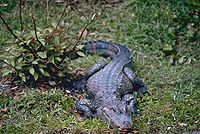
Photo from wikipedia
Abstract Habitat loss and degradation are among the leading causes of local extinctions, so it is crucially important to preserve and restore the remaining critical habitat increasingly critical to conserve… Click to show full abstract
Abstract Habitat loss and degradation are among the leading causes of local extinctions, so it is crucially important to preserve and restore the remaining critical habitat increasingly critical to conserve biodiversity. However, mechanisms driving species extinction often begin with habitat loss and seldom are well understood, which is greatly limits our ability to mitigate their impacts. The Chinese Alligator (Alligator sinensis) is a critically endangered crocodilian, which is narrowly distributed in very small six regions of Anhui province, China. In the present study, we used 9 nuclear microsatellite loci genotyped across the taxon's distribution area to investigate genetic variation and population demography in A. sinensis. The Chinese Alligator showed unusually low levels of genetic diversity (Na, 5.44; Ne, 1.97; He, 0.47) based on 793 individuals. Msvar analyses found recent signals of population decline reflecting a bottleneck (an approximately 9-fold decrease) about 25,000 years ago. Ecological niche modelling indicated that the habitat area has declined (about 8–15 fold) for A. sinensis when compared with that under different historical climatic conditions. Our results indicated that population decline and habitat loss in critically endangered Chinese Alligators may have acted as intrinsic and extrinsic factors that have impacted the current status of A. sinensis. In addition, these two unfavorable factors may have also directly contributed to a reduction in the genetic diversity of A. sinensis.
Journal Title: Global Ecology and Conservation
Year Published: 2019
Link to full text (if available)
Share on Social Media: Sign Up to like & get
recommendations!